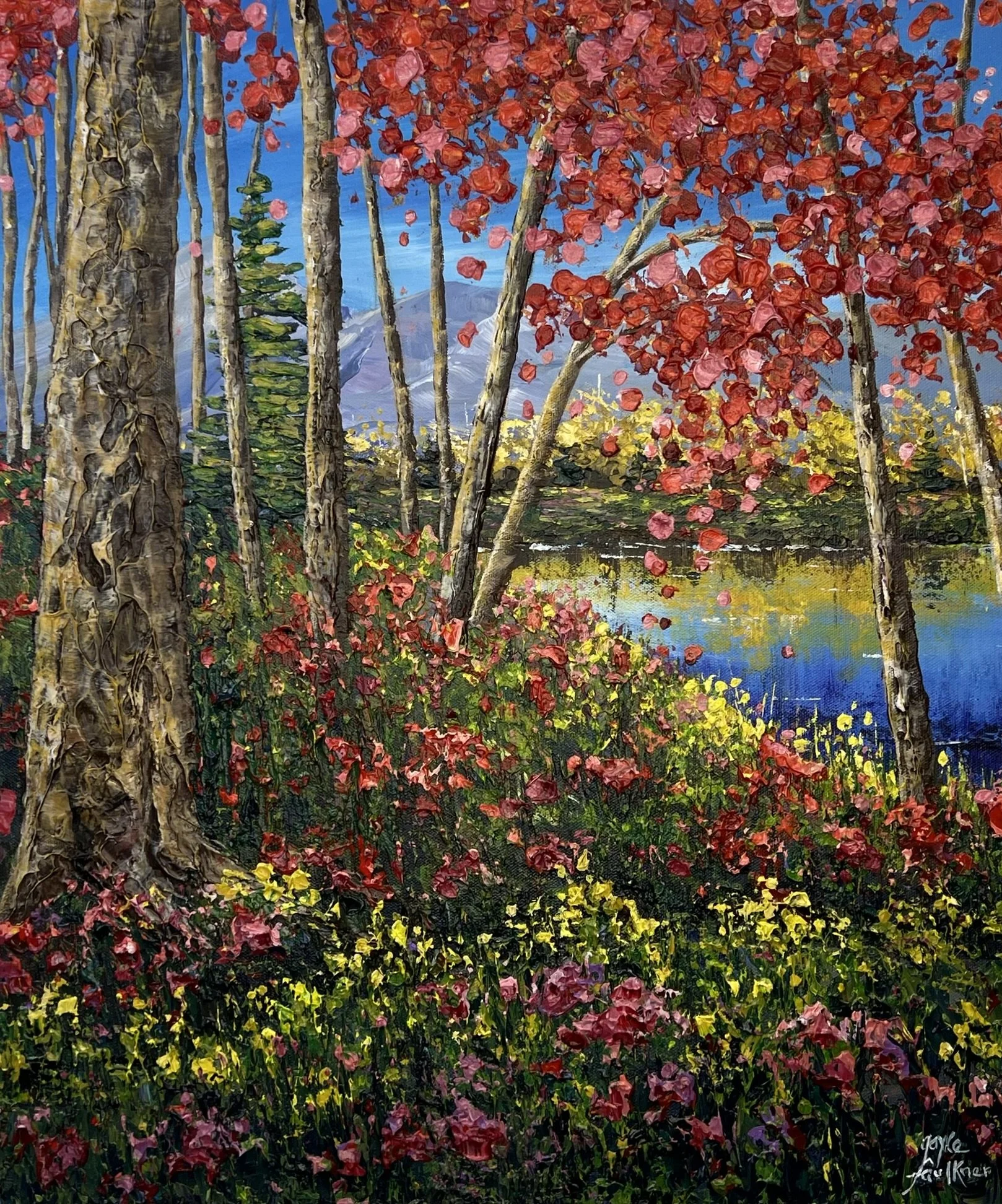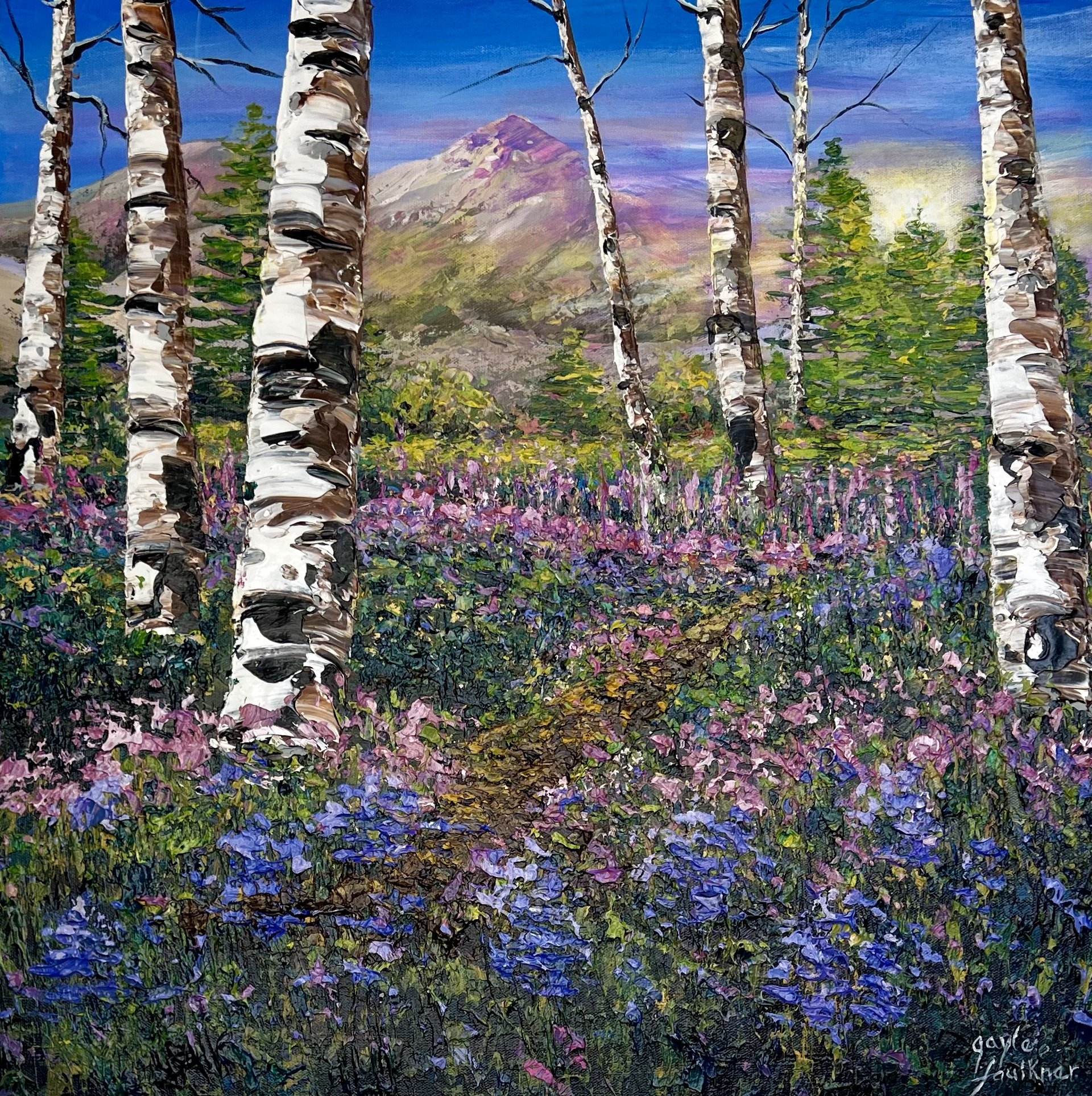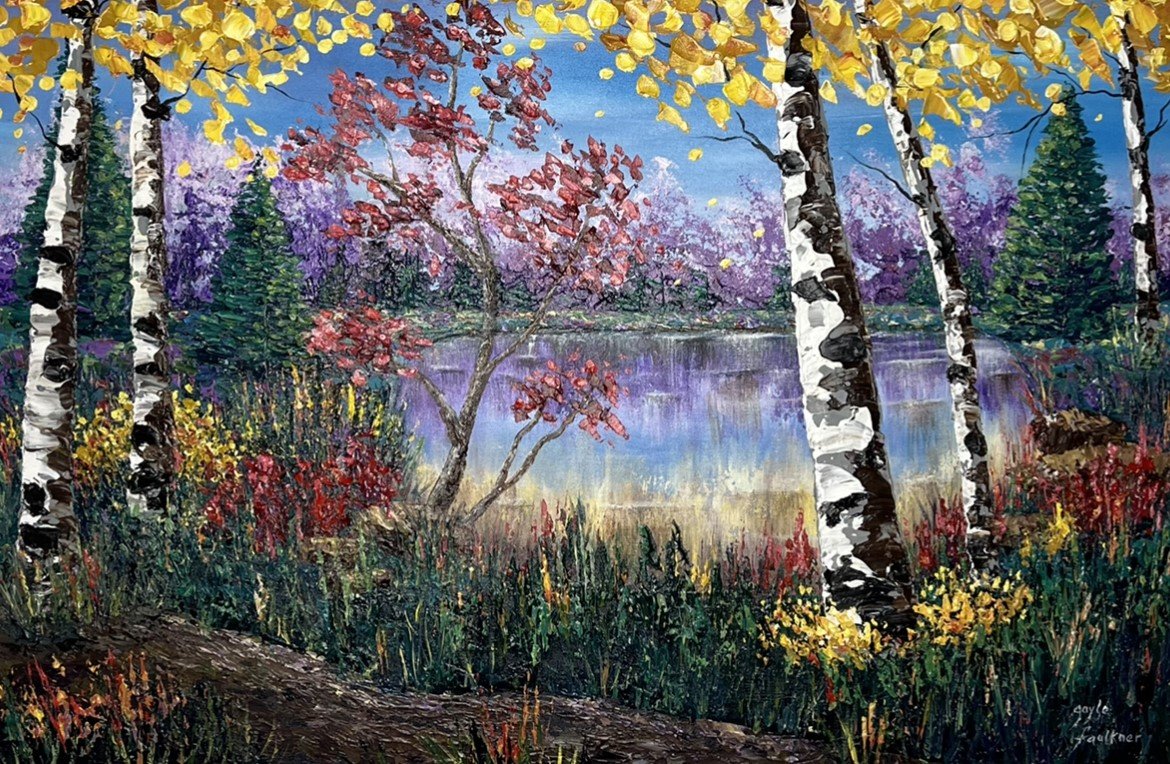Gayle Faulkner
Gayle Faulkner
https://gaylefaulknerfineart.com
Gayle Faulkner's artistic oeuvre is a testament to the transformative power of color, texture, and emotion in visual art. Faulkner, with her extensive experience spanning over three and a half decades, presents a portfolio rich in diversity and vibrancy. Her works in watercolor, acrylic, and murals demonstrate not only her mastery of technique but also her profound ability to evoke the human spirit's connection to nature.
Each piece by Faulkner is a unique journey through a stylized natural world. She captures the ethereal beauty of the aspen and birch trees with a palpable texture that almost invites the touch. Her use of a palette knife to apply thick, bold strokes of acrylic paint creates a three-dimensional effect that makes her work immediately recognizable. The vividness of her colors ranges from the soft pastels of a tranquil dawn to the fiery hues of autumn, showcasing her remarkable ability to play with light and shadow.
What sets Faulkner's art apart is her capacity to imbue each canvas with a life of its own. Her sceneries are not mere representations; they are experiences. The viewers find themselves drawn into the landscapes, surrounded by the rustling leaves and the gentle sway of the flora. There is a sense of movement in her static images, a characteristic that is both intriguing and comforting.
In pieces such as "Autumn's Paintbrush" and "Woodland Shadows," Faulkner goes beyond mere depiction; she conjures a sensory realm where one can almost hear the crunch of leaves and feel the crisp air. Her series of aspen and birch trees are not just studies of form but are imbued with a character that is almost human in its expression. "Glowing" and "Places Dulcet" resonate with a peaceful solitude, while the dynamic composition of "Peek-A-Boo" offers a playful contrast.
Faulkner’s work invites a dialogue with the viewer, a silent conversation between the soul and the elements of nature. Her art is not just seen; it is felt. It resonates with the collective unconscious, tapping into the universal love for nature’s untouched beauty. Gayle Faulkner's paintings are not only a feast for the eyes but also nourishment for the soul, a rare quality that makes her work truly extraordinary in the world of contemporary art. Her legacy is one of relentless exploration and a reminder of the serenity that can be found in the natural world, making her contributions both unique and invaluable.
Gayle Faulkner's body of work encapsulates a journey through the seasons, capturing the ephemeral beauty of the natural world with a tactile intensity that is as rare as it is captivating. Her canvases are not mere landscapes; they are portals to moments suspended in time, each brushstroke a testament to the intimate dance between artist and environment.
In Faulkner's work, the aspen and birch trees are recurring motifs, standing tall as silent witnesses to the passage of time. Her technique imbues these arboreal subjects with a dynamic quality, their textured bark and fluttering leaves rendered with an almost musical rhythm. The vibrancy and depth she achieves through her application of paint create an illusion of life that pulsates from the canvas. "Aspen Birch Majestic" and "Aspen Birch Stained Glass" exemplify this, where the trees are not static but appear to be in a state of gentle vibration, as if a breeze is perpetually flowing through their branches.
Faulkner’s pieces, like "Autumn's Paintbrush" and "Glowing," are symphonies of color that speak to the soul's longing for beauty and peace. The rich, impasto textures that she layers on her canvases invite the observer to reach out and trace the contours of her world, a world where every leaf and petal is alive with the artist's touch. The impulsive and yet deliberate strokes of her palette knife create a dynamic interplay of light and shadow, giving her work an almost sculptural quality.
Her murals and larger works are expansive narratives that unfold across walls and spaces, transforming them into immersive environments. These pieces serve as communal touchstones, public artworks that invite collective contemplation and introspection. The scale of these works showcases Faulkner's versatility and her ability to adapt her intimate style to grand proportions without losing the essence of her artistic voice.
Faulkner's art also possesses a lyrical quality, each piece a visual poem composed of color and form. In "Woodland Shadows" and "Places Dulcet," she paints not just the visual splendor of the forest but also its silent melody—the whispering of leaves, the soft footfalls on a mossy floor, the distant call of a bird. Her landscapes are alive with the music of nature, a silent sonata that plays on the strings of the viewer's imagination.
Faulkner’s landscapes are infused with an intrinsic optimism. In works such as "Peek-A-Boo" and "Gayle Faulkner Glowing," one can sense a celebration of life’s resilience, a homage to nature’s enduring splendor. The boldness of her palette conveys a defiance against the transience of seasons, her trees stand not as mere subjects but as vibrant characters in an ever-unfolding narrative.
Gayle Faulkner’s art is a dialogue with the sublime, a confluence where human emotion meets the majesty of the natural world. Her works are not just unique; they are a repository of the feelings that nature evokes within us all—wonder, serenity, nostalgia, and a profound sense of connection to the world around us. Her paintings are more than visual delights; they are spiritual experiences that resonate with anyone who has ever found solace in the arms of nature. Gayle's artistic expression finds a resonance with the emotive force of the Romantic painters, yet her technique bears the impasto hallmark reminiscent of the Post-Impressionist masters. Like the Romanticism, Faulkner delves into the sublime, capturing the awe-inspiring power and beauty of nature. Her scenes are not unlike those of Caspar David Friedrich, where each landscape is an invitation to reflect on one's own place within the natural world. However, where Friedrich offers contemplative stillness, Faulkner injects a vivid dynamism, a celebration of nature's vibrancy.
In technique, Faulkner's textured application of paint and her bold, visible brushstrokes echo the passionate works of Vincent van Gogh. The tactile quality of her work invites comparison to van Gogh's "Starry Night," where the swirling heavens seem to pulsate with an inner light. Faulkner's aspens and birches, with their thickly daubed bark, have a similar intensity, their forms almost quivering with energy on the canvas.
Yet, Faulkner is distinct. Her palettes are uniquely her own, her scenes neither as brooding as Friedrich's nor as tormented as van Gogh's. They are celebrations of color, light, and texture that communicate joy and tranquility. In a modern context, Gayle Faulkner stands as a bridge between the emotive landscapes of the old masters and the contemporary yearning for a connection with the serene and untouched aspects of the natural world.
Gayle Faulkner's artistic expression finds a resonance with the emotive force of the Romantic painters, yet her technique bears the impasto hallmark reminiscent of the Post-Impressionist masters. Like the Romantics, Faulkner delves into the sublime, capturing the awe-inspiring power and beauty of nature. Her scenes are not unlike those of Caspar David Friedrich, where each landscape is an invitation to reflect on one's own place within the natural world. However, where Friedrich offers contemplative stillness, Faulkner injects a vivid dynamism, a celebration of nature's vibrancy.
Her paintings offer a tactile experience in an era where the digital often supersedes the physical. This commitment to texture and palpability sets her apart and speaks to a growing desire among art enthusiasts and collectors for works that evoke a sense of physical presence and connection. Faulkner's use of vibrant colors and bold textures is a celebration of nature's diversity, resonating with a contemporary audience that values environmental consciousness and sustainability.
Faulkner’s ability to capture the essence of natural beauty aligns with the eco-centric themes prevalent in much of today's art, making her work not only visually appealing but also thematically relevant. As an artist, she stands in the interstice between the timeless allure of the natural world and the evolving discourse on humanity's relationship with nature. Her art is both a sanctuary and a statement, a harmonious blend of the familiar and the innovative, securing her place in the tapestry of contemporary art.
Gayle Faulkner's artistic repertoire is a vibrant testament to the enduring allure of the natural world, rendered through a lens that is as textured and nuanced as the landscapes she depicts. Her work stands out in the contemporary art scene as a beacon of sensory richness and environmental homage, bridging the gap between the traditional and the avant-garde. Faulkner's paintings are not just visual experiences but multisensory journeys that resonate with the collective desire for connection to nature and its restorative powers.
As we move further into an age dominated by technology and urbanization, Faulkner's art becomes an ever-more poignant sanctuary, inviting us to pause, reflect, and find solace in the beauty of the untouched world. Her canvases serve as vibrant reminders of the world's natural splendors, offering an escape to a place where the rustle of leaves and the quiet strength of trees prevail.
In her blend of Romantic sensibilities with Post-Impressionist techniques, Faulkner carves a distinctive niche for herself, one that celebrates the spirit of the old masters while speaking profoundly to contemporary audiences. Gayle Faulkner’s works stand as enduring contributions to the arts, capturing the essence of the times while maintaining a timeless conversation with the viewers. Her place in the art world is both secured and celebrated, her canvases a legacy of the emotive power of art to connect us with the profound beauty of the world around us.
By Marta Puig
Editor Contemporary Art Curator Magazine
Aspen.Birch Climbing 18x24
Aspen.Birch Deep Woods...Mossy
Aspen.Birch Majestic 24x24
Aspen.Birch Majestic 24x24
Gayle Faulkner Autumn's Paintbrush, Textural Acrylic - Copy
Gayle Faulkner Illuminatioin Textural Acrylic
Gayle Faulkner Illuminatioin Textural Acrylic
Gayle Faulkner Illuminatioin Textural Acrylic
Places Dulcet 36 x 24
Gayle Faulkner Glowing Textural Acrylic 2100













